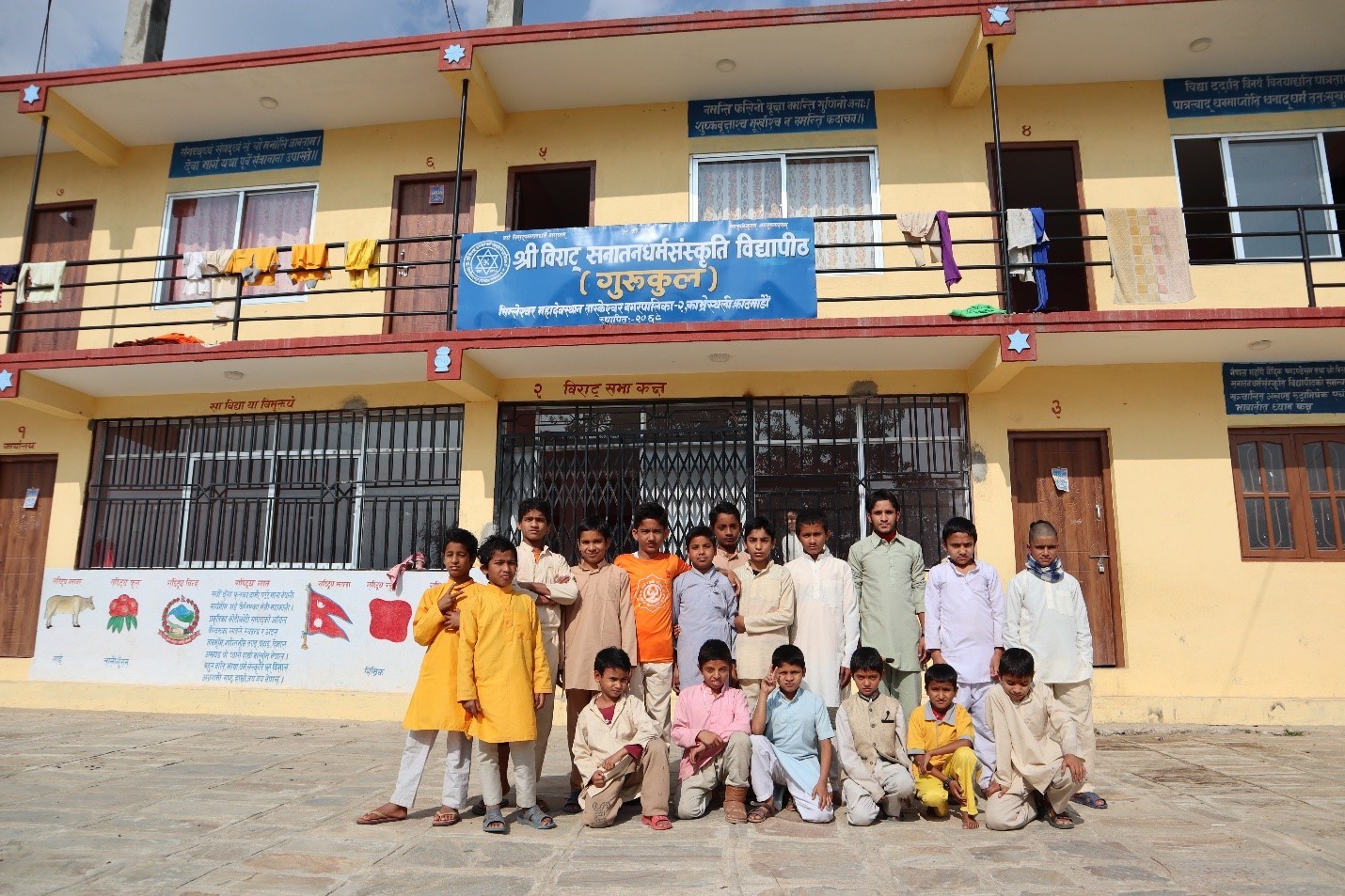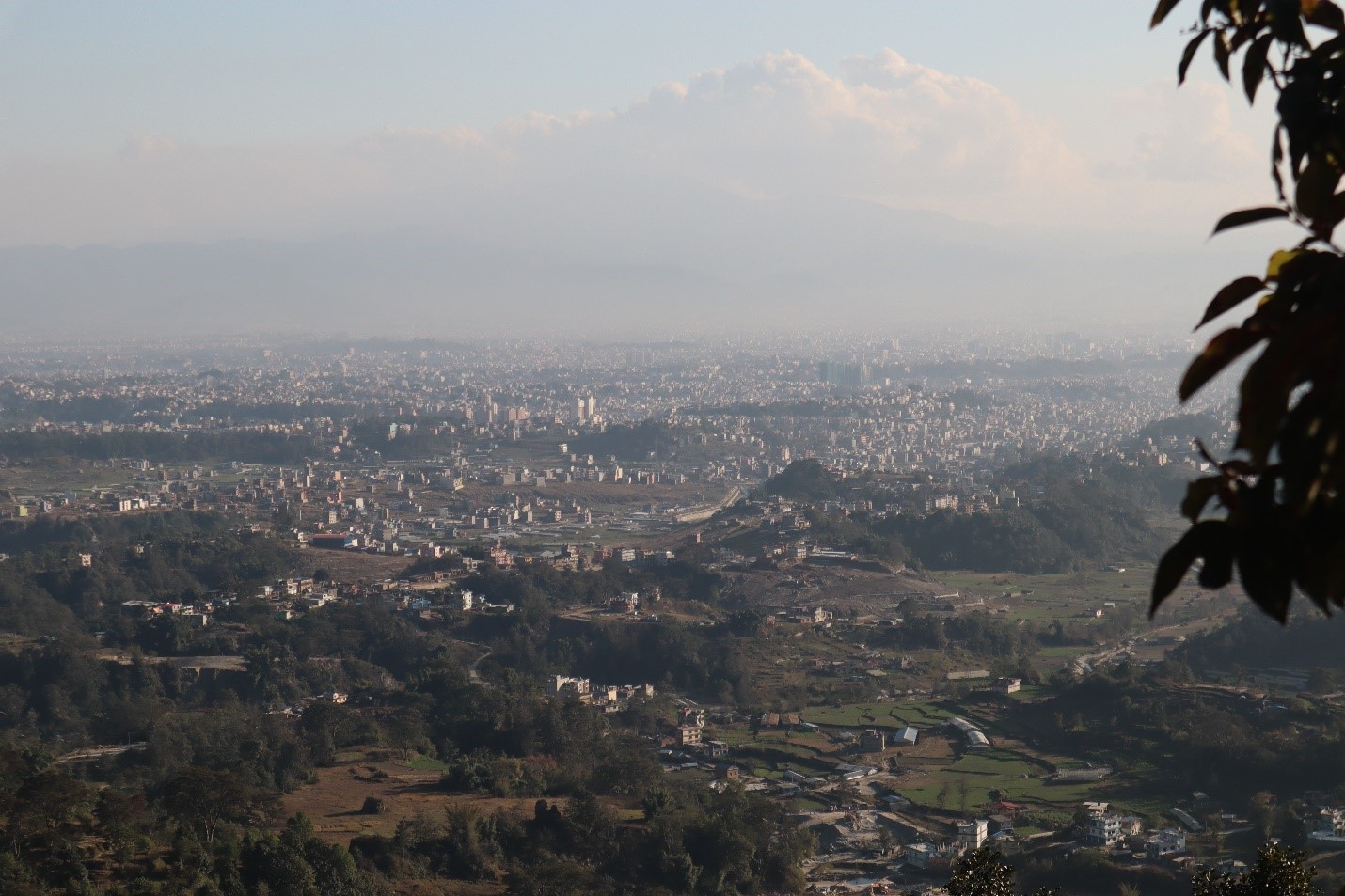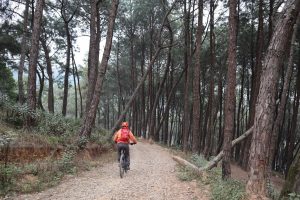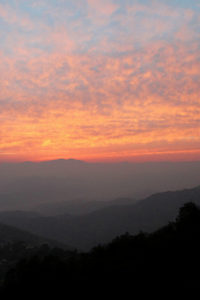I thought I would be strong enough in a week to ride my mountain bike again to Shantidham snugly tucked away amidst lush woods in the verdant hills of Kavresthali.
The little mishap I had in the last ride prevented me, however, from riding for almost two weeks. Some 50 yards before the holy site, a dog suddenly attacked, and I took a nasty fall. My left elbow and my bruised knee hurt severely from the knock. I made it to the holy site, though.
My long experience has taught me not to attempt far-off remote places alone, and by no account, after dark, a rule of thumb every biker—a beginner or old hand—should follow. I broke the rule that day.
Flashback
On a ride to Kavresthali hills, I was sipping tea at a teashop at Sangla when I overheard a woman talking animatedly to the owner lady, about having seen the holy temple of Badrinath in Shantidham. I could not believe my ears. I had only known the Badrinath Dham located in Uttarakhand, India. “It is just four kilometres away from here,” she said. I could not wait to hop onto my saddle. Although a little late in the afternoon, I rode off, consumed with the thought of seeing the temple for myself.
Some half-hour later, at the arch sign: “Way to Shantidham.” The lady I met had asked me to take a better road one-half kilometre further down. But I kept on as I thought it would save time and be back home before dark. As I pedalled uphill, shortly, I had to get off my bike as the dirt track was too steep and badly washed out by past monsoon rains.

Soon I realised I was the only soul around. The track led uphill into woods with no sign of any habitation. As thick shrubs and the woods started, it suddenly occurred chances of wild animals from the Shivpuri National Park straying into them at dusk were not unlikely.
Sightings of both leopards, and at times black bears, were often reported in fringe areas of the park, including Kavresthali hills. Had it been daytime, not much to worry, but after dark, it was a different story.
In two minds
Shadows lengthened, signalling an approach of dusk. I began to waver, torn between two minds. One told me, to back out, the other kept goading me—no guts, no glory—I should not give up. The dense woods got quieter as I dragged my bike uphill. Birds seemed to end their flurry to slowly turn-in, winding up their dusk chorus.
My restless mind started seeing things in darkened shrubs that looked menacing. The debate between my inner voices continued. Before long, darkness fell, and I switched on my lights. Except for my heavy breathing, and the bike’s dragging sound, the total hush felt spooky. I kept going, weary and edgy, though.
Soon, trees and underbrush seemed to play tricks on my eyes as the beam of light fell upon them. What was that? Did I hear a rustling in the nearby shrub? Perhaps, a leopard lurking in the undergrowth? My imagination ran riot.
Even the faint sound of a stream in the stillness felt too loud. Then a hoot of an owl tore through the silence. I froze. I was near panic when, suddenly, I saw an illumination some 50 yards ahead, on the darkened hill. Phew, hope at last!
Off to Shantidham
I had my old partner, Shayeet, accompany me the second ride to Shantidham. We chose the dirt road I had backtracked on my earlier trip. My elbow and knee still hurt a little despite the fortnight rest.
It barely took us half-hour from our residence at Milan Tole, Tokha Road, to Manmaiju heights. We then took a downhill that led to open fields with stubbles from cut paddy.
As we crossed a sullied stream, a strong stench filled our nostrils from pig and poultry farms spread out along the track. “Ugh, what disgusting smell,” cried out Shayeet.
Thati Chowk
A little later, we met a paved road that headed north. Shortly, we were at Thati Chowk, Pipalbot, Kavresthali. A huge pipal tree (Ficus religiosa) bounded by a Shiva temple stood in the middle of the road. A bit further, we stopped for tea at Sangam Chowk. Tea stalls and shops flanked the street.


After a refreshing cup of buffalo-milk-tea (my favourite) and a breather, we hit a dirt track. The country road ran across farmland with roadside houses. As lush-rolling hills rose in north, terraced fields gradually descended to the sprawling city core.
Every time I rode that route, the wayside seemed to roll up more houses, while trees and foliage receded. The countryside looked all set to make rapid inroads into urban sprawl. It was, though, gratifying to the eyes and the mind to see what little tilled land and lush foliage the countryside still held.
Ten minutes later, the dirt road headed down a slope to a copse of trees and met a fork. The left had an arch-gate that read: Shantidham Entrance, Welcome. The right went to Bihani Chowk. Next followed a gruelling incline.

Gurukul
We stopped by a temple called Shimleswor Mahadev to recover our breath and sip water from our bottle. Next to the shrine, we saw students from a Sanskrit academy, engaged in some game. They seemed curious to share some knowledge about their Gurukul (seminary) with us. Shayeet even had them grouped up for a photograph.

To our great displeasure, the climb did not let up for what seemed a lifetime. We but kept on stoically, both riding and walking our bikes. “Uncle, this uphill must be the toughest we have done together,” 19-year old Shayeet remarked. As I reflected on that, I patted myself on the back and smiled because I was 67 and still going strong.
The road left behind houses and shops and entered the woods. Suddenly, the place appeared familiar as I spotted the fork. Then it flashed on my mind the road that went down I had come last time.
Shortly, I noticed the house where the dog attacked me on my previous ride, and I crashed. I told Shayeet to be on guard as it might rush at us. To our great relief, there was no sign of the dog. Ten minutes later, we made it to Shantidham.

Shantidham
I had looked upon the internet the photographs of Badrinath Temple, located in Uttarakhand, India before we started. The temple was indeed a commendable work at replicating the authentic edifice from India.

As I looked closely, I noticed the temple building at Shantidham had red-tiled roof, whereas the picture on the internet showed Badrinath Temple from India with a gilded roof. Other disparities on the façade appeared insignificant.


Shantidham, however, included additional structures like the tall column that held on top idols of different deities. An annex provided living quarters for priests and the Swamiji, the founder of the holy establishment.

I noticed a raised pulpit in the forecourt for religious recitations from the Swamiji. The striking feature, as the name Shantidham suggested, was the tranquil surroundings bounded by tall mix trees including pine, and shrub jungle. As lush wooded hills rose in the northwest, the elevation afforded a view of distant mountains and the Kathmandu Valley.


An inscription on the column in the forecourt read, “Inaugurated in 2074 BS by the President, Mrs Bidya Devi Bhandari.” One of the pillars of the annex building caught my attention. It held a display-board that included names of financial donors to the establishment; some amounts crossed six figures.
Shortly, Shayeet and I entered the temple building to pay our homage. The main gate opened to a courtyard with verandahs on three sides. A red-tile three-tier pagoda-style tall minaret stood in the middle. Idols of Jaya-Vijaya, the dwarpalakas (gatekeepers) to Lord Vishnu, flanked the doorway.
The main chamber housed a black granite idol of Lord Vishnu, festooned with ornate gold necklaces. I noticed one of them included a pendant shaped into an ‘Om’ symbol. An automated dholak (drum) used during the arati ritual sat at one corner.

As an intricate silver shade hung over the idol of Lord Vishnu, a gilded halo surrounded the bust. Lord Vishnu donned a jewelled crown holding a Sudarshan Chakra (a spinning disc used by the god as weapons) with the index finger of his right hand and a conch by his left.
Going by Hindu theology, Gods Rama and Krishna are considered the incarnations of Lord Vishnu. Lord Vishnu is also said to be part of the Hindu Trimurti (a triad of three gods), or the sacred ‘Hindu Trinity’ as Brahma, the Creator; Shiva, the Destroyer; and Vishnu, the Preserver. Photography inside the chamber was not allowed.

Swamiji
As I missed out on my last visit meeting the principal founder of Shantidham, Swamiji, Shri Chaturbhujacharya Chundamani Maharaji, I could not wait to see him. I hastened to ask the priest, Kumar Acharya, to arrange an audience with Swamiji. Kumarji not only informed me the Swami was available but also obliged by arranging the meeting.
We did not have to wait long. In less than 10 minutes, a bearded man dressed in a saffron dhoti, a kameez, and a shawl, wrapped around his shoulder, looking in his early 30s, with long flowing locks and a big sandalwood tika on his forehead, appeared; that was Swamiji.
In response to my Namaste, he smiled back with folded hands and motioned us to the raised dais built for pravachans or preachings from Swamiji, and seated himself before a small desk. Before I could put a question, Swamiji broke into a chant and recited a Sanskrit shloka (verse). I waited patiently.
To my question what inspired him to set upon the formidable task of building the holy temple of Badrinath in Shantidham, the Swamiji appeared very composed: “During my stay in India, I came across many Nepali pilgrims travelling to Chardham, namely: Rameswaram, Jagannath Puri, Dwarka, and the Badrinath. Most of them included elderly people.”
“For them,” Swamiji continued, “Travelling hundreds of miles in India was extremely demanding. First, it involved a lot of expenses, not everyone could afford it; and secondly, travelling long distances by buses and trains in India for the Nepalis was arduous and hectic. A lot of people fell ill, especially the elderly.”
After a little pause, Swamiji added, “So, it just struck me if the Nepali devotees could pay their homage to those four holy places right here in Nepal, it would save them all the hassle, time and money.”
“With the blessings and divine favour of God and the support of the devotees, we have at this stage completed the first project, the Badrinath Temple. The future will have the rest of three dhams, too,” concluded Swamiji reciting a shloka.
Later, Swamiji shared with me his early days at Varanasi, India, where he studied Sanskrit and completed his Vidyavaridhi (PhD). He also taught at different Sanskrit colleges in India. He travelled extensively to a great many holy places in India before venturing out on this mission single-mindedly.
As Swamiji left the rostrum, I could not help admire his staunch dedication to embark upon the ambitious task for the cause of the Nepali devotees. He sounded confident and determined.
In hindsight
As we left, it crossed my mind, maybe, I’d not have made the second visit to Shantidham if I had backed off that day, or perhaps I mused amusingly, become a perfect dinner for the leopard lurking behind the shrubs. I kept wondering our way back home what drove me to it against my better judgment.
How to go?
First, go to Balaju Bypass (Machha Pokhari) and head for Nepaltar. At Nepaltar, after crossing a bridge close to an army barrack, take a left turn and head for Jarankhu. The road goes along the Sheshmati River (Mahadev Khola). After Jarankhu, go towards Sangam Chowk. After half a kilometre from Sangam Chowk towards Bihani Chowk, you will see an arch-gate to your left with a sign that reads Shantidham. Just follow the road. The distance to the Dham is three kilometres from Sangam Chowk.
All the images except the Indian Badrinath Dham are photographed by the author.



















